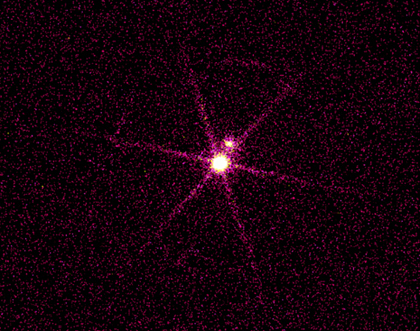Sirius is really two stars. A faint white dwarf, Sirius B, is locked in a dance with Sirius A, and it takes 50 years for them to orbit each other. Sirius B used to be a big guy: it was once a red giant. Except it doesn’t have quite the same mass as Betelgeuse, a red supergiant, which will one day contract into an even denser object: a neutron star or a black hole.
But Sirius B is dense, really dense. Packed into a sphere about the size of our Earth, Sirius B’s total mass is equivalent to that of our sun. Weightlifters would be keen to get a piece of Little B, as a teaspoon weighs several tonnes!
As the brightest of the ‘fixed stars’, Sirius has held special significance since ancient times. To the Egyptians, its ascension heralded the flooding of the Nile. They called the star Sopdet after an important fertility goddess. To the Greeks, Sirius signalled the beginning of summer and they attributed its influence to madness and desire (so if I’m acting creepier than usual, it’s because Sirius is rising).
To the Romans, Sirius was a malign influence that had to be propitiated. How did they do this? By sacrificing a dog. And not just any dog, the cutest puppy they could find in Rome. (I made the last bit up – the puppy didn’t have to be cute.) This occurred at the peak of summer during the Robigalia festival. If all went according to plan, the next harvest would be free from blight.

In Chinese tradition Sirius is the dog 天狼 tianlang, meaning sky wolf.
Those dogon Dogons
The Dog Star arguably carries the most mystical baggage of all the twinklers. One need look no further than the Dogon tribes (there’s that dog again) of Mali and Burkina Faso. Anthropologists have claimed that the Dogon knew already, before contact with the West, that Sirius was a binary system.
It was only in 1844 that German astronomer Friedrich Bessel postulated the existence of Sirius B, based on the motion of A. This hypothesis was not confirmed until American telescope maker Alvan Graham Clark observed the twin directly in 1862.
In Dogon cosmology, Sirius A possesses a small dense white companion, called Po Tolo, that can’t be seen with the naked eye. For a balanced appraisal of the Dogon connection, see PR Pesch, The Dogon and Sirius.
Sirius A and B have no known planets, although there’s possibly a third, even dimmer star, orbiting close to Sirius A. Since the end of the nineteenth century, scientists have observed orbital irregularities in the system, leading them to believe that if there is a companion, it’s probably an exoplanet, or brown dwarf not much larger than Jupiter.

Although Sirius is currently the brightest star in our sky, this won’t last forever. The Dog is bounding towards us, but when it starts receding it will become fainter, until Vega becomes the brightest star. Before Sirius, 90,000 years ago, Canopus held the title, and will again after Vega.
The red Sirius anomaly
Our modern pronunciation comes from the Greek, Seirios Σείριος although the Egyptian god Osiris has also been proposed as a source. Seirios means scorching, and this could simply connote that the star is very bright.
But could it also mean that the visible star was once red, because Sirius B has transitioned from red supergiant to white dwarf in the last few thousand years? This would make it another controversial colour changer, like Betelgeuse, which some claim has, since antiquity, transitioned from yellow main sequence star to red supergiant.
To see how complicated the matter is you only have to look at the spaghetti trail in DCB Whittet’s, “A physical interpretation of the ‘red Sirius’ anomaly”, in the Monthly Notices of the Royal Astronomical Society. In his second century Almagest, Ptolemy classed Sirius alongside Aldebaran, Antares, Arcturus, Betelgeuse and Pollux as reddish (hipokeros).
RC Ceragioli, in the Journal for the History of Astronomy, “The Debate Concerning ‘Red’ Sirius”, refers to the controversy as a “long standing question…an astronomical albatross perpetually circling at a distance from mainstream theory…”
Ceragioli easily dismisses the citations of Greek poet Aratus, as well as Romans Cicero (‘translator’ of Aratus) and Horace. But he is less convincing trying to refute mentions of red Sirius by Avienus and Seneca.
That famous blazing dog
For Aratus, Sirius “piercingly scorches”, while for Cicero it “shines with a ruddy light that famous blazing Dog”. Neither ‘scorches’ or ‘ruddy’ expressly indicate red. However, Avienus refers to Sirius as red 80 times in his Phaenomena, while Seneca pronounces:
Nor is it strange if the Earth’s exhalation is of every sort and diverse, when in the sky too the colour of objects is not uniform, but rather the red of the dog star is piercing, while that of Mars is mild and Jupiter has none, its glow being translated into clear light. [Naturales Quaestiones]
Ceragioli asserts that what Seneca actually means is that Sirius’s colour is piercing (acrior), “vivid and striking, while Mars’s [colour] is flat.” But perhaps Cicero is discussing the colour of extra-terrestrial objects when viewed through an “exhalation” of the Earth, perhaps a volcanic eruption. The idea that ancient astronomers made their observations at twilight, when many stars appear reddish, seems a little too facile. Surely these ancient astronomers would have made some sort of disclaimer that they were making their observations during sunrise or sunset.
Today most astronomers believe it is unlikely Sirius has undergone stage transition since antiquity. So another explanation could be that an interstellar dust colour intercepted our line of sight. However, Whittet has debunked this theory, stating that Sirius would be too dim to see with the naked eye if an intervening medium was red shifting its light.
So, maybe its just aliens who flick a switch now and then, turning the star red to save energy.
More on the Sirius twins:
Spectral type: A: A0mA1 Va (main sequence) | B: DA2 (white dwarf)
Apparent magnitude (V): A: -1.46 | B: 8.44
Absolute magnitude: A: +1.43 | B: +11.18
Mass: A: 2.063 | B: 1.018 solar masses
Temperature: A: 9940K | B: 25000K
Distance: 8.6 light years
Age: A: ≈242 | ≈228 million years
In Tales from the Orion Arm, the Sirians evolved quickly due to significant radiation levels in the Sirian binary system.
